Analysis of Maritime Safety Pillars and Human Element in Shipping
VerifiedAdded on 2023/04/22
|11
|2135
|230
Report
AI Summary
This report provides an in-depth analysis of maritime safety, emphasizing the influence of the human element on the marine industry. It explores key safety pillars, including SOLAS, STCW Convention, MARPOL, and MLC 2006, and their roles in maintaining safety standards. The report discusses various threats to maritime security, such as piracy, smuggling, and pollution, and highlights the significance of international efforts and regulations. It examines the positive and negative impacts of the human element, such as communication, knowledge, and working environment, on shipping operations and accident prevention. The conclusion underscores the human element's crucial role in maritime safety and the importance of supporting pillars in maintaining safety standards and mitigating risks related to human factors and vessel transportation. The report aims to provide a comprehensive understanding of the interconnectedness of these elements in ensuring a safe and secure maritime environment.
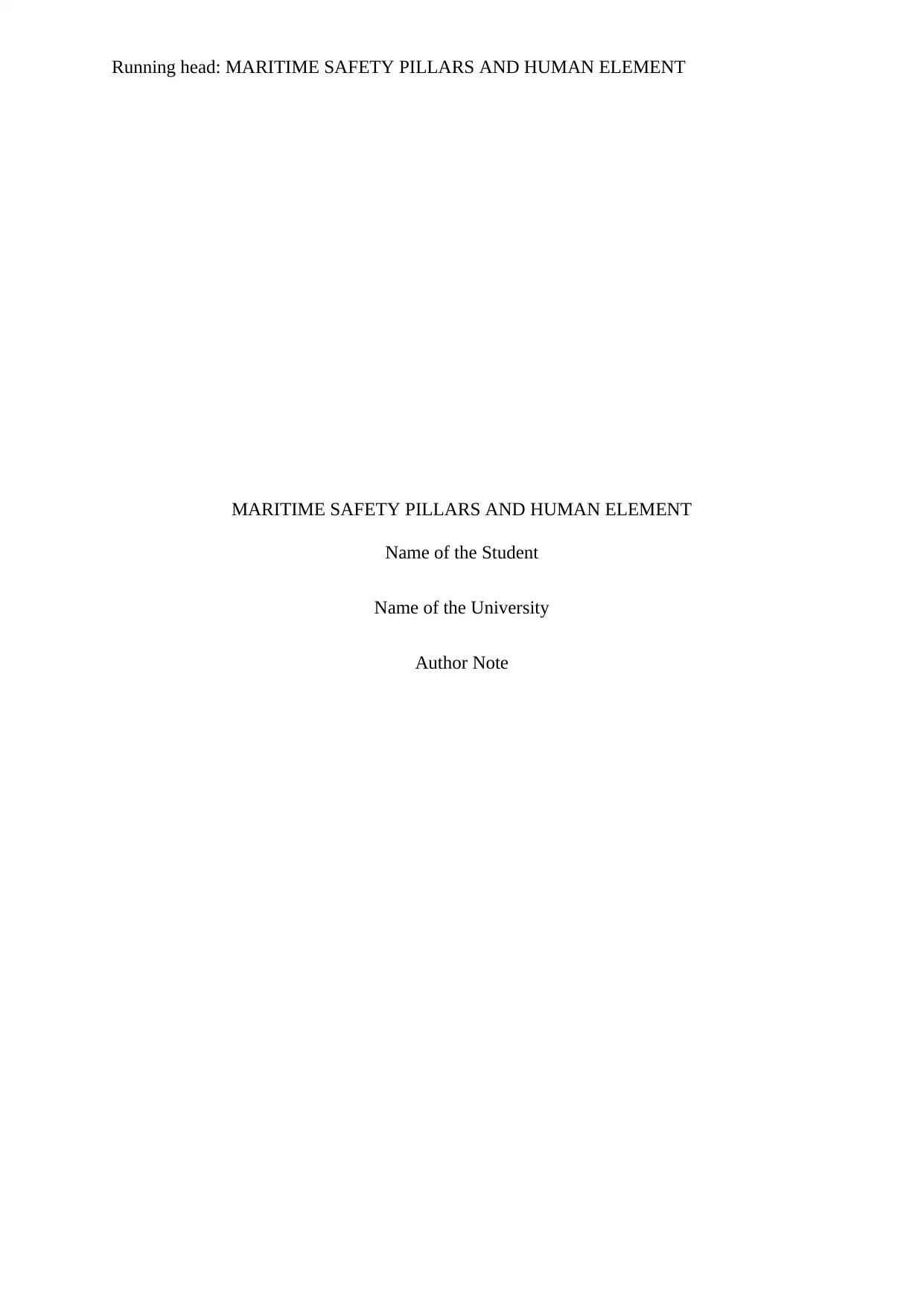
Running head: MARITIME SAFETY PILLARS AND HUMAN ELEMENT
MARITIME SAFETY PILLARS AND HUMAN ELEMENT
Name of the Student
Name of the University
Author Note
MARITIME SAFETY PILLARS AND HUMAN ELEMENT
Name of the Student
Name of the University
Author Note
Paraphrase This Document
Need a fresh take? Get an instant paraphrase of this document with our AI Paraphraser
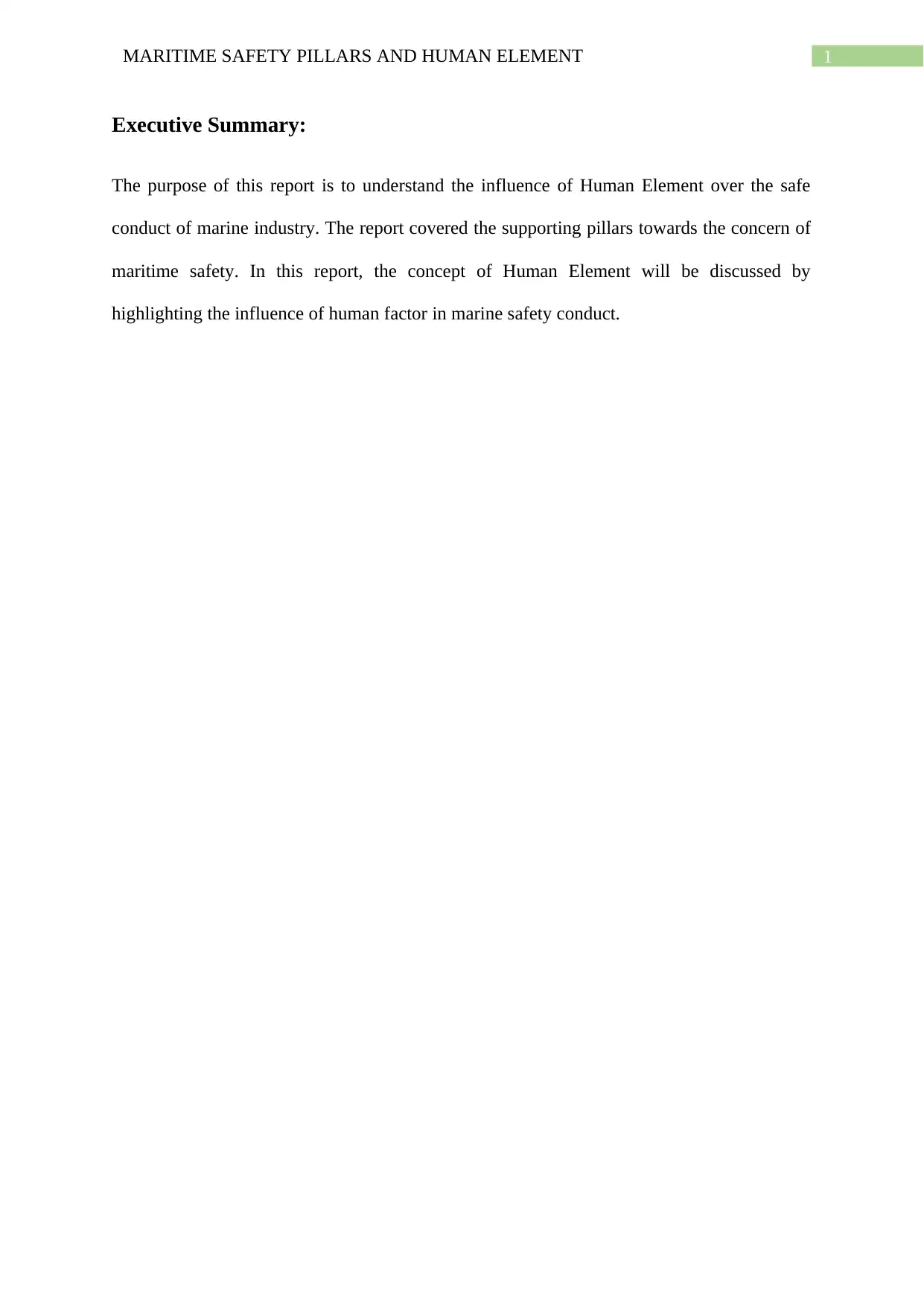
1MARITIME SAFETY PILLARS AND HUMAN ELEMENT
Executive Summary:
The purpose of this report is to understand the influence of Human Element over the safe
conduct of marine industry. The report covered the supporting pillars towards the concern of
maritime safety. In this report, the concept of Human Element will be discussed by
highlighting the influence of human factor in marine safety conduct.
Executive Summary:
The purpose of this report is to understand the influence of Human Element over the safe
conduct of marine industry. The report covered the supporting pillars towards the concern of
maritime safety. In this report, the concept of Human Element will be discussed by
highlighting the influence of human factor in marine safety conduct.
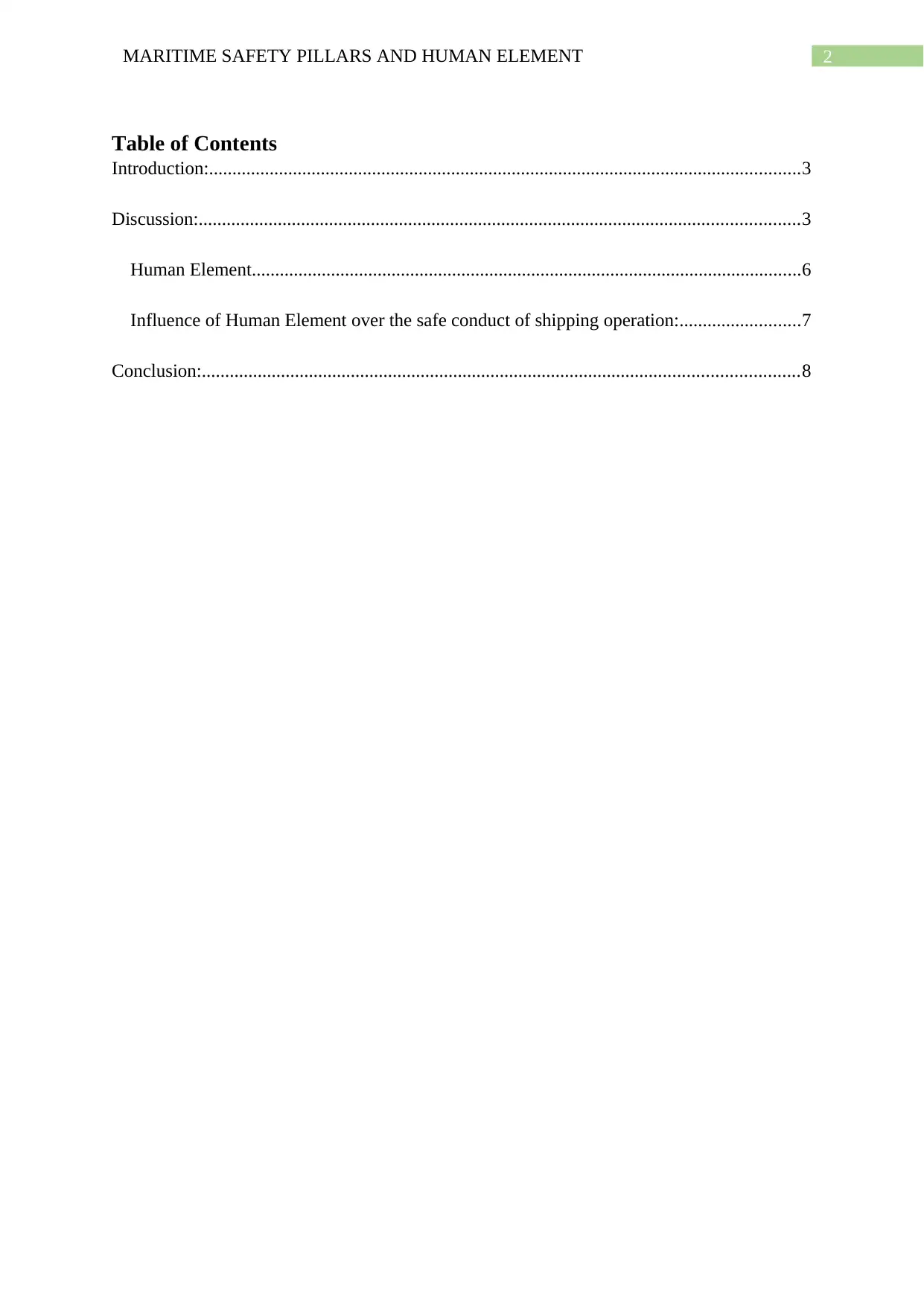
2MARITIME SAFETY PILLARS AND HUMAN ELEMENT
Table of Contents
Introduction:...............................................................................................................................3
Discussion:.................................................................................................................................3
Human Element......................................................................................................................6
Influence of Human Element over the safe conduct of shipping operation:..........................7
Conclusion:................................................................................................................................8
Table of Contents
Introduction:...............................................................................................................................3
Discussion:.................................................................................................................................3
Human Element......................................................................................................................6
Influence of Human Element over the safe conduct of shipping operation:..........................7
Conclusion:................................................................................................................................8
⊘ This is a preview!⊘
Do you want full access?
Subscribe today to unlock all pages.

Trusted by 1+ million students worldwide
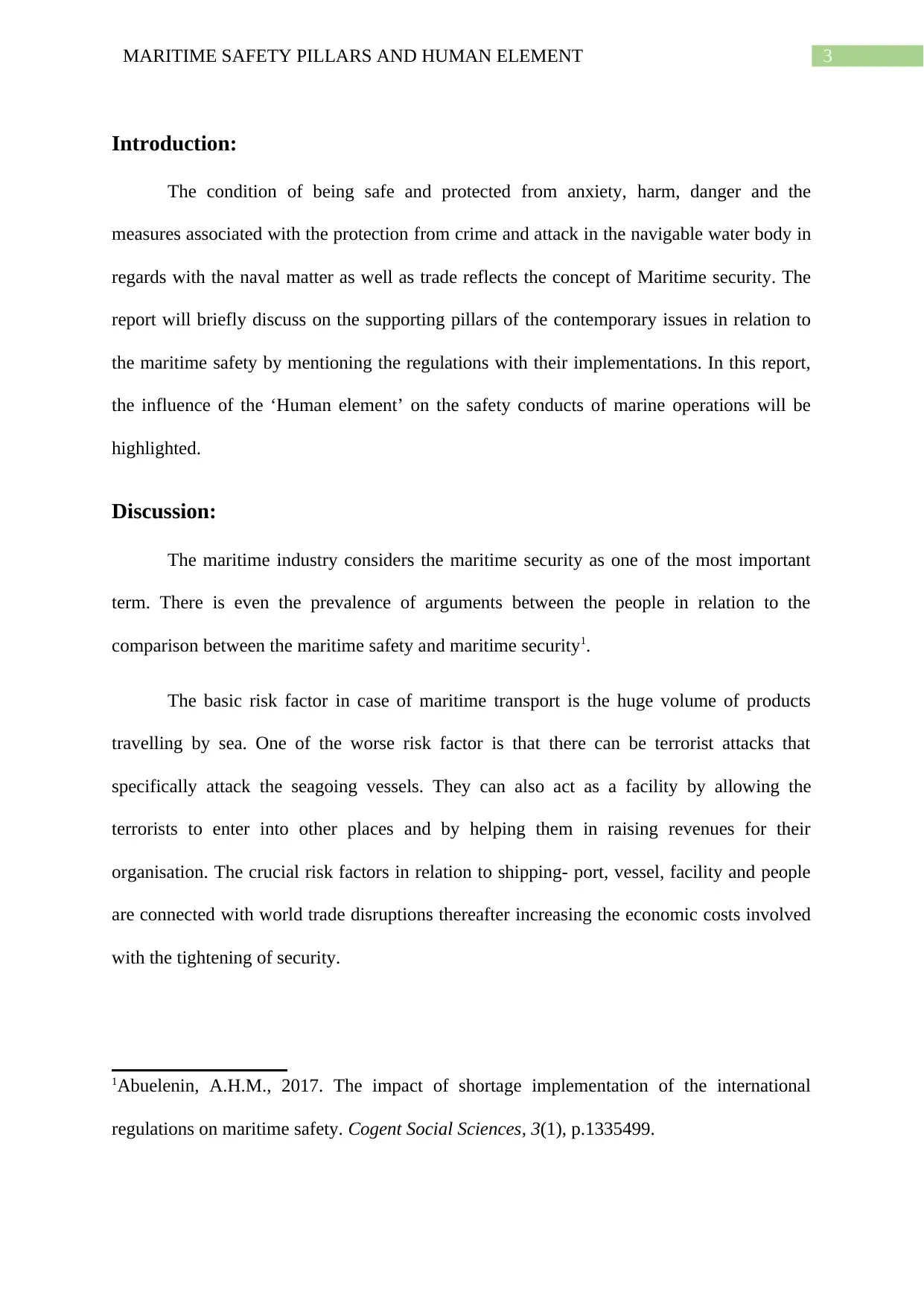
3MARITIME SAFETY PILLARS AND HUMAN ELEMENT
Introduction:
The condition of being safe and protected from anxiety, harm, danger and the
measures associated with the protection from crime and attack in the navigable water body in
regards with the naval matter as well as trade reflects the concept of Maritime security. The
report will briefly discuss on the supporting pillars of the contemporary issues in relation to
the maritime safety by mentioning the regulations with their implementations. In this report,
the influence of the ‘Human element’ on the safety conducts of marine operations will be
highlighted.
Discussion:
The maritime industry considers the maritime security as one of the most important
term. There is even the prevalence of arguments between the people in relation to the
comparison between the maritime safety and maritime security1.
The basic risk factor in case of maritime transport is the huge volume of products
travelling by sea. One of the worse risk factor is that there can be terrorist attacks that
specifically attack the seagoing vessels. They can also act as a facility by allowing the
terrorists to enter into other places and by helping them in raising revenues for their
organisation. The crucial risk factors in relation to shipping- port, vessel, facility and people
are connected with world trade disruptions thereafter increasing the economic costs involved
with the tightening of security.
1Abuelenin, A.H.M., 2017. The impact of shortage implementation of the international
regulations on maritime safety. Cogent Social Sciences, 3(1), p.1335499.
Introduction:
The condition of being safe and protected from anxiety, harm, danger and the
measures associated with the protection from crime and attack in the navigable water body in
regards with the naval matter as well as trade reflects the concept of Maritime security. The
report will briefly discuss on the supporting pillars of the contemporary issues in relation to
the maritime safety by mentioning the regulations with their implementations. In this report,
the influence of the ‘Human element’ on the safety conducts of marine operations will be
highlighted.
Discussion:
The maritime industry considers the maritime security as one of the most important
term. There is even the prevalence of arguments between the people in relation to the
comparison between the maritime safety and maritime security1.
The basic risk factor in case of maritime transport is the huge volume of products
travelling by sea. One of the worse risk factor is that there can be terrorist attacks that
specifically attack the seagoing vessels. They can also act as a facility by allowing the
terrorists to enter into other places and by helping them in raising revenues for their
organisation. The crucial risk factors in relation to shipping- port, vessel, facility and people
are connected with world trade disruptions thereafter increasing the economic costs involved
with the tightening of security.
1Abuelenin, A.H.M., 2017. The impact of shortage implementation of the international
regulations on maritime safety. Cogent Social Sciences, 3(1), p.1335499.
Paraphrase This Document
Need a fresh take? Get an instant paraphrase of this document with our AI Paraphraser
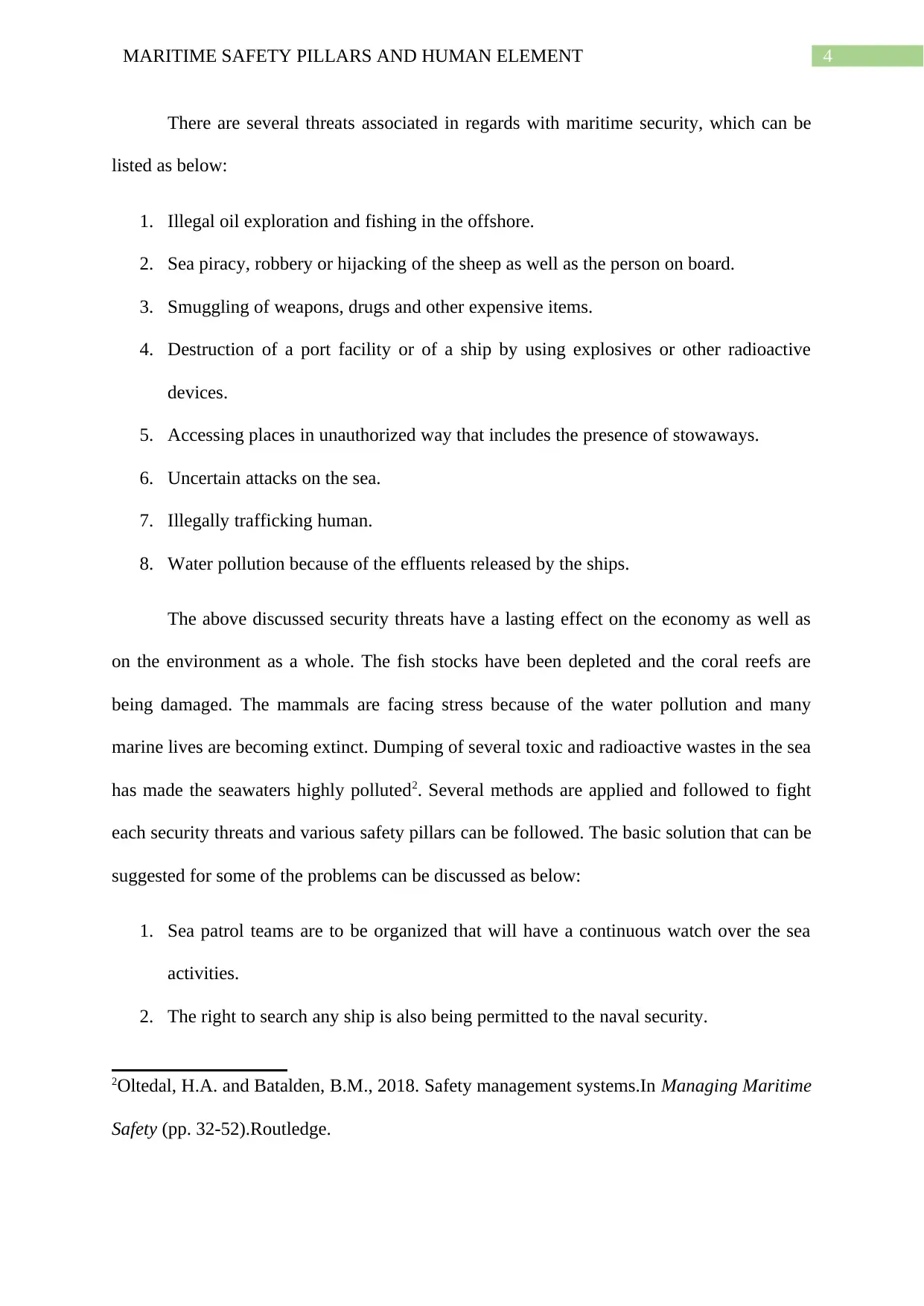
4MARITIME SAFETY PILLARS AND HUMAN ELEMENT
There are several threats associated in regards with maritime security, which can be
listed as below:
1. Illegal oil exploration and fishing in the offshore.
2. Sea piracy, robbery or hijacking of the sheep as well as the person on board.
3. Smuggling of weapons, drugs and other expensive items.
4. Destruction of a port facility or of a ship by using explosives or other radioactive
devices.
5. Accessing places in unauthorized way that includes the presence of stowaways.
6. Uncertain attacks on the sea.
7. Illegally trafficking human.
8. Water pollution because of the effluents released by the ships.
The above discussed security threats have a lasting effect on the economy as well as
on the environment as a whole. The fish stocks have been depleted and the coral reefs are
being damaged. The mammals are facing stress because of the water pollution and many
marine lives are becoming extinct. Dumping of several toxic and radioactive wastes in the sea
has made the seawaters highly polluted2. Several methods are applied and followed to fight
each security threats and various safety pillars can be followed. The basic solution that can be
suggested for some of the problems can be discussed as below:
1. Sea patrol teams are to be organized that will have a continuous watch over the sea
activities.
2. The right to search any ship is also being permitted to the naval security.
2Oltedal, H.A. and Batalden, B.M., 2018. Safety management systems.In Managing Maritime
Safety (pp. 32-52).Routledge.
There are several threats associated in regards with maritime security, which can be
listed as below:
1. Illegal oil exploration and fishing in the offshore.
2. Sea piracy, robbery or hijacking of the sheep as well as the person on board.
3. Smuggling of weapons, drugs and other expensive items.
4. Destruction of a port facility or of a ship by using explosives or other radioactive
devices.
5. Accessing places in unauthorized way that includes the presence of stowaways.
6. Uncertain attacks on the sea.
7. Illegally trafficking human.
8. Water pollution because of the effluents released by the ships.
The above discussed security threats have a lasting effect on the economy as well as
on the environment as a whole. The fish stocks have been depleted and the coral reefs are
being damaged. The mammals are facing stress because of the water pollution and many
marine lives are becoming extinct. Dumping of several toxic and radioactive wastes in the sea
has made the seawaters highly polluted2. Several methods are applied and followed to fight
each security threats and various safety pillars can be followed. The basic solution that can be
suggested for some of the problems can be discussed as below:
1. Sea patrol teams are to be organized that will have a continuous watch over the sea
activities.
2. The right to search any ship is also being permitted to the naval security.
2Oltedal, H.A. and Batalden, B.M., 2018. Safety management systems.In Managing Maritime
Safety (pp. 32-52).Routledge.
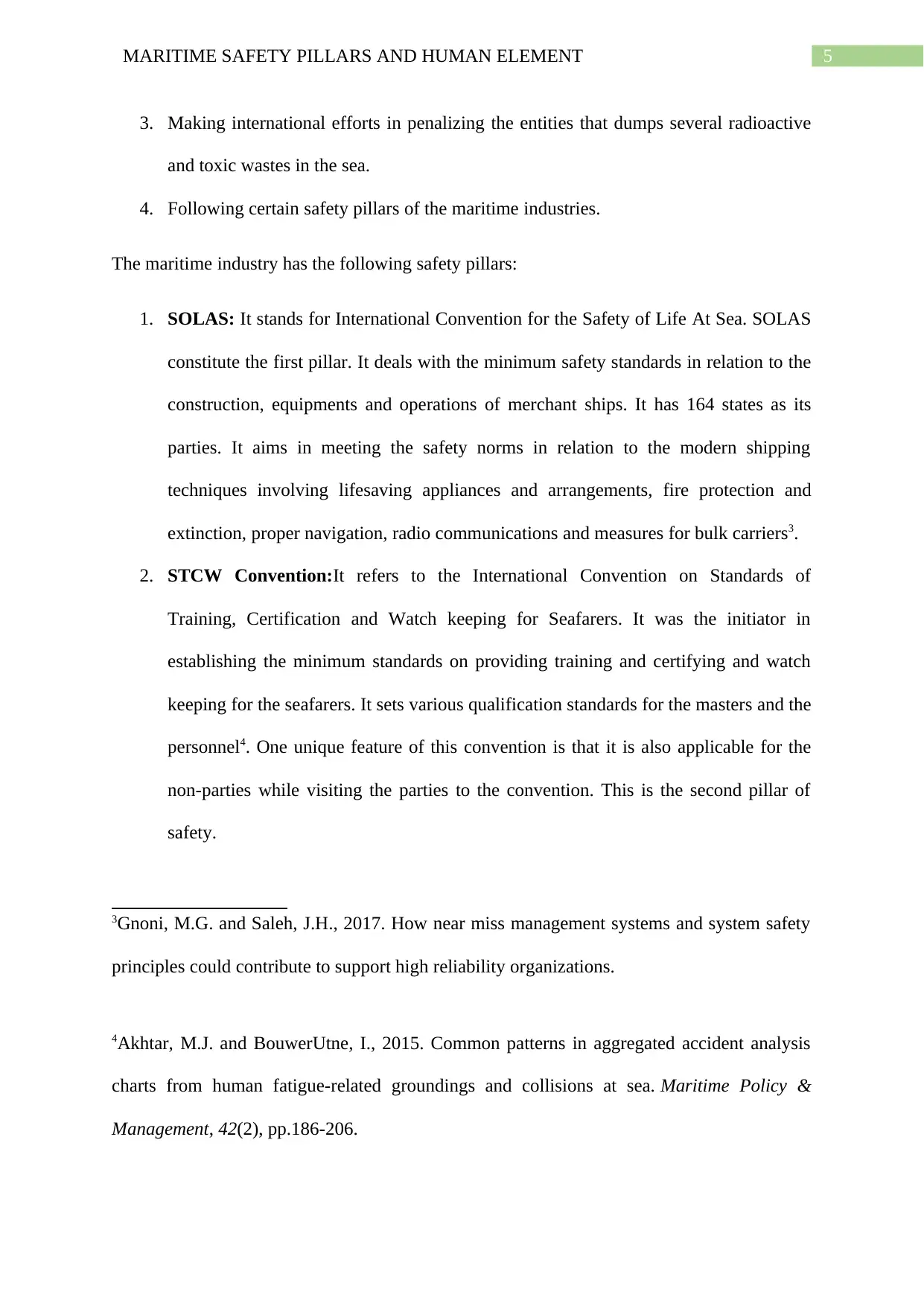
5MARITIME SAFETY PILLARS AND HUMAN ELEMENT
3. Making international efforts in penalizing the entities that dumps several radioactive
and toxic wastes in the sea.
4. Following certain safety pillars of the maritime industries.
The maritime industry has the following safety pillars:
1. SOLAS: It stands for International Convention for the Safety of Life At Sea. SOLAS
constitute the first pillar. It deals with the minimum safety standards in relation to the
construction, equipments and operations of merchant ships. It has 164 states as its
parties. It aims in meeting the safety norms in relation to the modern shipping
techniques involving lifesaving appliances and arrangements, fire protection and
extinction, proper navigation, radio communications and measures for bulk carriers3.
2. STCW Convention:It refers to the International Convention on Standards of
Training, Certification and Watch keeping for Seafarers. It was the initiator in
establishing the minimum standards on providing training and certifying and watch
keeping for the seafarers. It sets various qualification standards for the masters and the
personnel4. One unique feature of this convention is that it is also applicable for the
non-parties while visiting the parties to the convention. This is the second pillar of
safety.
3Gnoni, M.G. and Saleh, J.H., 2017. How near miss management systems and system safety
principles could contribute to support high reliability organizations.
4Akhtar, M.J. and BouwerUtne, I., 2015. Common patterns in aggregated accident analysis
charts from human fatigue-related groundings and collisions at sea. Maritime Policy &
Management, 42(2), pp.186-206.
3. Making international efforts in penalizing the entities that dumps several radioactive
and toxic wastes in the sea.
4. Following certain safety pillars of the maritime industries.
The maritime industry has the following safety pillars:
1. SOLAS: It stands for International Convention for the Safety of Life At Sea. SOLAS
constitute the first pillar. It deals with the minimum safety standards in relation to the
construction, equipments and operations of merchant ships. It has 164 states as its
parties. It aims in meeting the safety norms in relation to the modern shipping
techniques involving lifesaving appliances and arrangements, fire protection and
extinction, proper navigation, radio communications and measures for bulk carriers3.
2. STCW Convention:It refers to the International Convention on Standards of
Training, Certification and Watch keeping for Seafarers. It was the initiator in
establishing the minimum standards on providing training and certifying and watch
keeping for the seafarers. It sets various qualification standards for the masters and the
personnel4. One unique feature of this convention is that it is also applicable for the
non-parties while visiting the parties to the convention. This is the second pillar of
safety.
3Gnoni, M.G. and Saleh, J.H., 2017. How near miss management systems and system safety
principles could contribute to support high reliability organizations.
4Akhtar, M.J. and BouwerUtne, I., 2015. Common patterns in aggregated accident analysis
charts from human fatigue-related groundings and collisions at sea. Maritime Policy &
Management, 42(2), pp.186-206.
⊘ This is a preview!⊘
Do you want full access?
Subscribe today to unlock all pages.

Trusted by 1+ million students worldwide
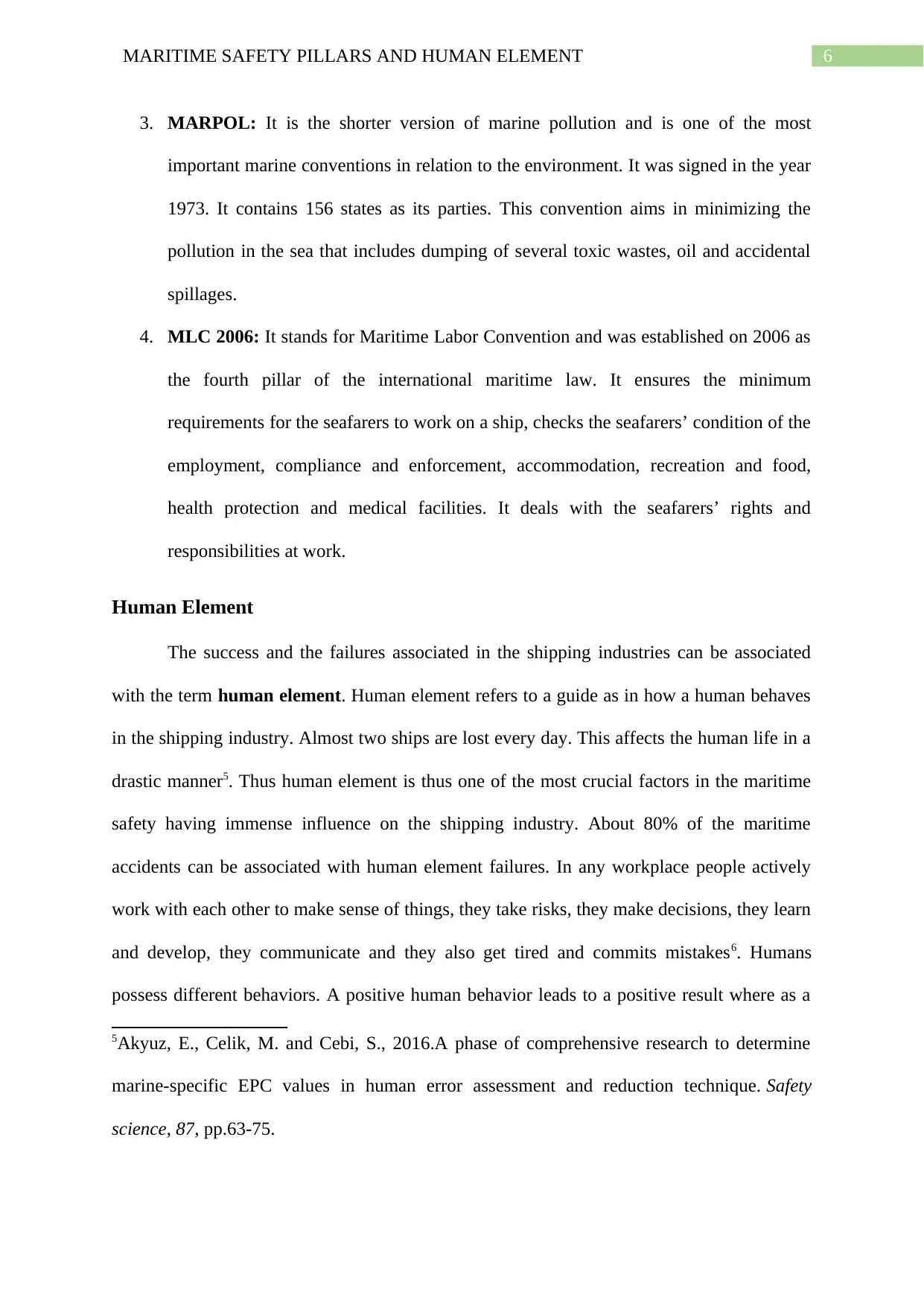
6MARITIME SAFETY PILLARS AND HUMAN ELEMENT
3. MARPOL: It is the shorter version of marine pollution and is one of the most
important marine conventions in relation to the environment. It was signed in the year
1973. It contains 156 states as its parties. This convention aims in minimizing the
pollution in the sea that includes dumping of several toxic wastes, oil and accidental
spillages.
4. MLC 2006: It stands for Maritime Labor Convention and was established on 2006 as
the fourth pillar of the international maritime law. It ensures the minimum
requirements for the seafarers to work on a ship, checks the seafarers’ condition of the
employment, compliance and enforcement, accommodation, recreation and food,
health protection and medical facilities. It deals with the seafarers’ rights and
responsibilities at work.
Human Element
The success and the failures associated in the shipping industries can be associated
with the term human element. Human element refers to a guide as in how a human behaves
in the shipping industry. Almost two ships are lost every day. This affects the human life in a
drastic manner5. Thus human element is thus one of the most crucial factors in the maritime
safety having immense influence on the shipping industry. About 80% of the maritime
accidents can be associated with human element failures. In any workplace people actively
work with each other to make sense of things, they take risks, they make decisions, they learn
and develop, they communicate and they also get tired and commits mistakes6. Humans
possess different behaviors. A positive human behavior leads to a positive result where as a
5Akyuz, E., Celik, M. and Cebi, S., 2016.A phase of comprehensive research to determine
marine-specific EPC values in human error assessment and reduction technique. Safety
science, 87, pp.63-75.
3. MARPOL: It is the shorter version of marine pollution and is one of the most
important marine conventions in relation to the environment. It was signed in the year
1973. It contains 156 states as its parties. This convention aims in minimizing the
pollution in the sea that includes dumping of several toxic wastes, oil and accidental
spillages.
4. MLC 2006: It stands for Maritime Labor Convention and was established on 2006 as
the fourth pillar of the international maritime law. It ensures the minimum
requirements for the seafarers to work on a ship, checks the seafarers’ condition of the
employment, compliance and enforcement, accommodation, recreation and food,
health protection and medical facilities. It deals with the seafarers’ rights and
responsibilities at work.
Human Element
The success and the failures associated in the shipping industries can be associated
with the term human element. Human element refers to a guide as in how a human behaves
in the shipping industry. Almost two ships are lost every day. This affects the human life in a
drastic manner5. Thus human element is thus one of the most crucial factors in the maritime
safety having immense influence on the shipping industry. About 80% of the maritime
accidents can be associated with human element failures. In any workplace people actively
work with each other to make sense of things, they take risks, they make decisions, they learn
and develop, they communicate and they also get tired and commits mistakes6. Humans
possess different behaviors. A positive human behavior leads to a positive result where as a
5Akyuz, E., Celik, M. and Cebi, S., 2016.A phase of comprehensive research to determine
marine-specific EPC values in human error assessment and reduction technique. Safety
science, 87, pp.63-75.
Paraphrase This Document
Need a fresh take? Get an instant paraphrase of this document with our AI Paraphraser
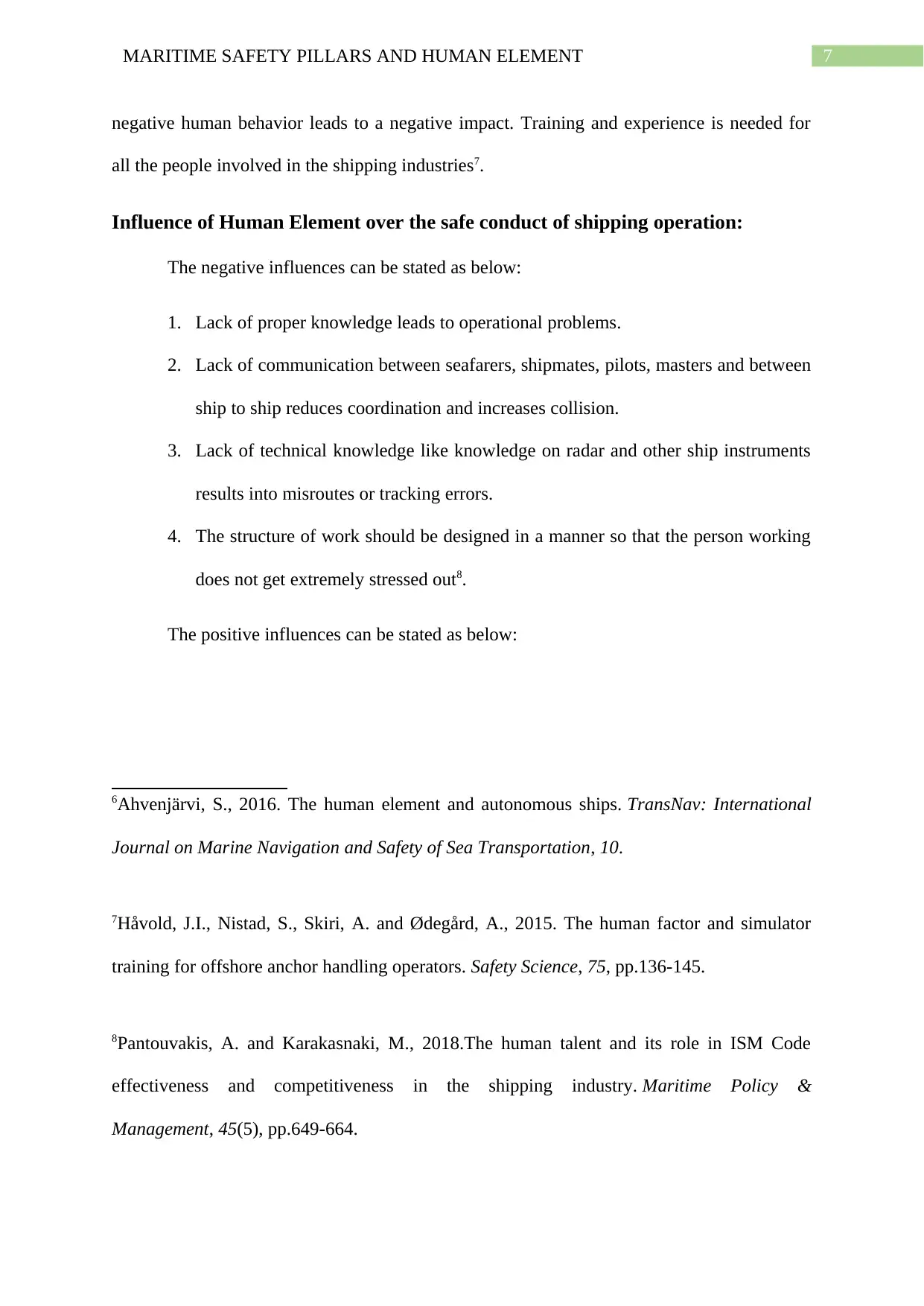
7MARITIME SAFETY PILLARS AND HUMAN ELEMENT
negative human behavior leads to a negative impact. Training and experience is needed for
all the people involved in the shipping industries7.
Influence of Human Element over the safe conduct of shipping operation:
The negative influences can be stated as below:
1. Lack of proper knowledge leads to operational problems.
2. Lack of communication between seafarers, shipmates, pilots, masters and between
ship to ship reduces coordination and increases collision.
3. Lack of technical knowledge like knowledge on radar and other ship instruments
results into misroutes or tracking errors.
4. The structure of work should be designed in a manner so that the person working
does not get extremely stressed out8.
The positive influences can be stated as below:
6Ahvenjärvi, S., 2016. The human element and autonomous ships. TransNav: International
Journal on Marine Navigation and Safety of Sea Transportation, 10.
7Håvold, J.I., Nistad, S., Skiri, A. and Ødegård, A., 2015. The human factor and simulator
training for offshore anchor handling operators. Safety Science, 75, pp.136-145.
8Pantouvakis, A. and Karakasnaki, M., 2018.The human talent and its role in ISM Code
effectiveness and competitiveness in the shipping industry. Maritime Policy &
Management, 45(5), pp.649-664.
negative human behavior leads to a negative impact. Training and experience is needed for
all the people involved in the shipping industries7.
Influence of Human Element over the safe conduct of shipping operation:
The negative influences can be stated as below:
1. Lack of proper knowledge leads to operational problems.
2. Lack of communication between seafarers, shipmates, pilots, masters and between
ship to ship reduces coordination and increases collision.
3. Lack of technical knowledge like knowledge on radar and other ship instruments
results into misroutes or tracking errors.
4. The structure of work should be designed in a manner so that the person working
does not get extremely stressed out8.
The positive influences can be stated as below:
6Ahvenjärvi, S., 2016. The human element and autonomous ships. TransNav: International
Journal on Marine Navigation and Safety of Sea Transportation, 10.
7Håvold, J.I., Nistad, S., Skiri, A. and Ødegård, A., 2015. The human factor and simulator
training for offshore anchor handling operators. Safety Science, 75, pp.136-145.
8Pantouvakis, A. and Karakasnaki, M., 2018.The human talent and its role in ISM Code
effectiveness and competitiveness in the shipping industry. Maritime Policy &
Management, 45(5), pp.649-664.
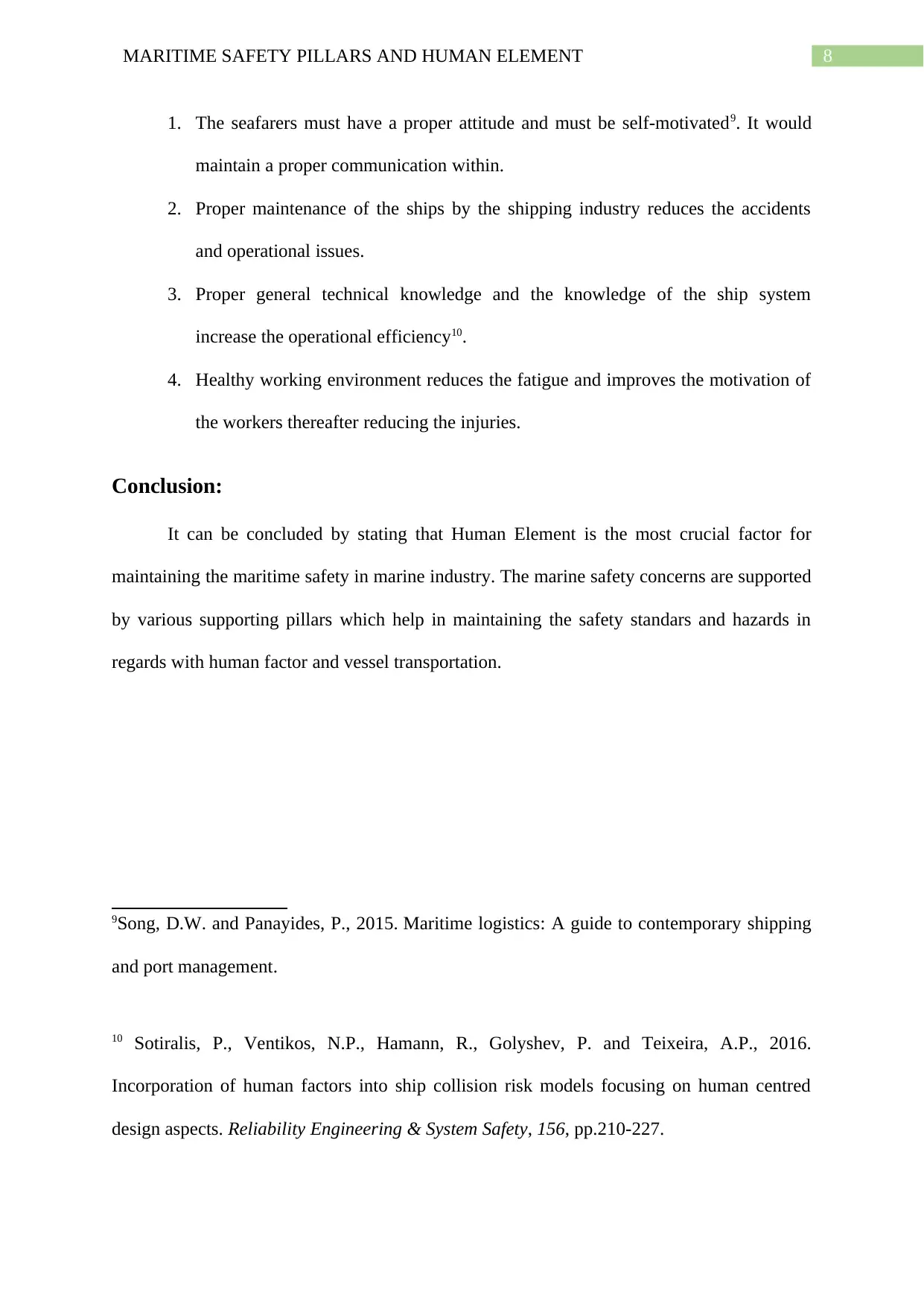
8MARITIME SAFETY PILLARS AND HUMAN ELEMENT
1. The seafarers must have a proper attitude and must be self-motivated9. It would
maintain a proper communication within.
2. Proper maintenance of the ships by the shipping industry reduces the accidents
and operational issues.
3. Proper general technical knowledge and the knowledge of the ship system
increase the operational efficiency10.
4. Healthy working environment reduces the fatigue and improves the motivation of
the workers thereafter reducing the injuries.
Conclusion:
It can be concluded by stating that Human Element is the most crucial factor for
maintaining the maritime safety in marine industry. The marine safety concerns are supported
by various supporting pillars which help in maintaining the safety standars and hazards in
regards with human factor and vessel transportation.
9Song, D.W. and Panayides, P., 2015. Maritime logistics: A guide to contemporary shipping
and port management.
10 Sotiralis, P., Ventikos, N.P., Hamann, R., Golyshev, P. and Teixeira, A.P., 2016.
Incorporation of human factors into ship collision risk models focusing on human centred
design aspects. Reliability Engineering & System Safety, 156, pp.210-227.
1. The seafarers must have a proper attitude and must be self-motivated9. It would
maintain a proper communication within.
2. Proper maintenance of the ships by the shipping industry reduces the accidents
and operational issues.
3. Proper general technical knowledge and the knowledge of the ship system
increase the operational efficiency10.
4. Healthy working environment reduces the fatigue and improves the motivation of
the workers thereafter reducing the injuries.
Conclusion:
It can be concluded by stating that Human Element is the most crucial factor for
maintaining the maritime safety in marine industry. The marine safety concerns are supported
by various supporting pillars which help in maintaining the safety standars and hazards in
regards with human factor and vessel transportation.
9Song, D.W. and Panayides, P., 2015. Maritime logistics: A guide to contemporary shipping
and port management.
10 Sotiralis, P., Ventikos, N.P., Hamann, R., Golyshev, P. and Teixeira, A.P., 2016.
Incorporation of human factors into ship collision risk models focusing on human centred
design aspects. Reliability Engineering & System Safety, 156, pp.210-227.
⊘ This is a preview!⊘
Do you want full access?
Subscribe today to unlock all pages.

Trusted by 1+ million students worldwide
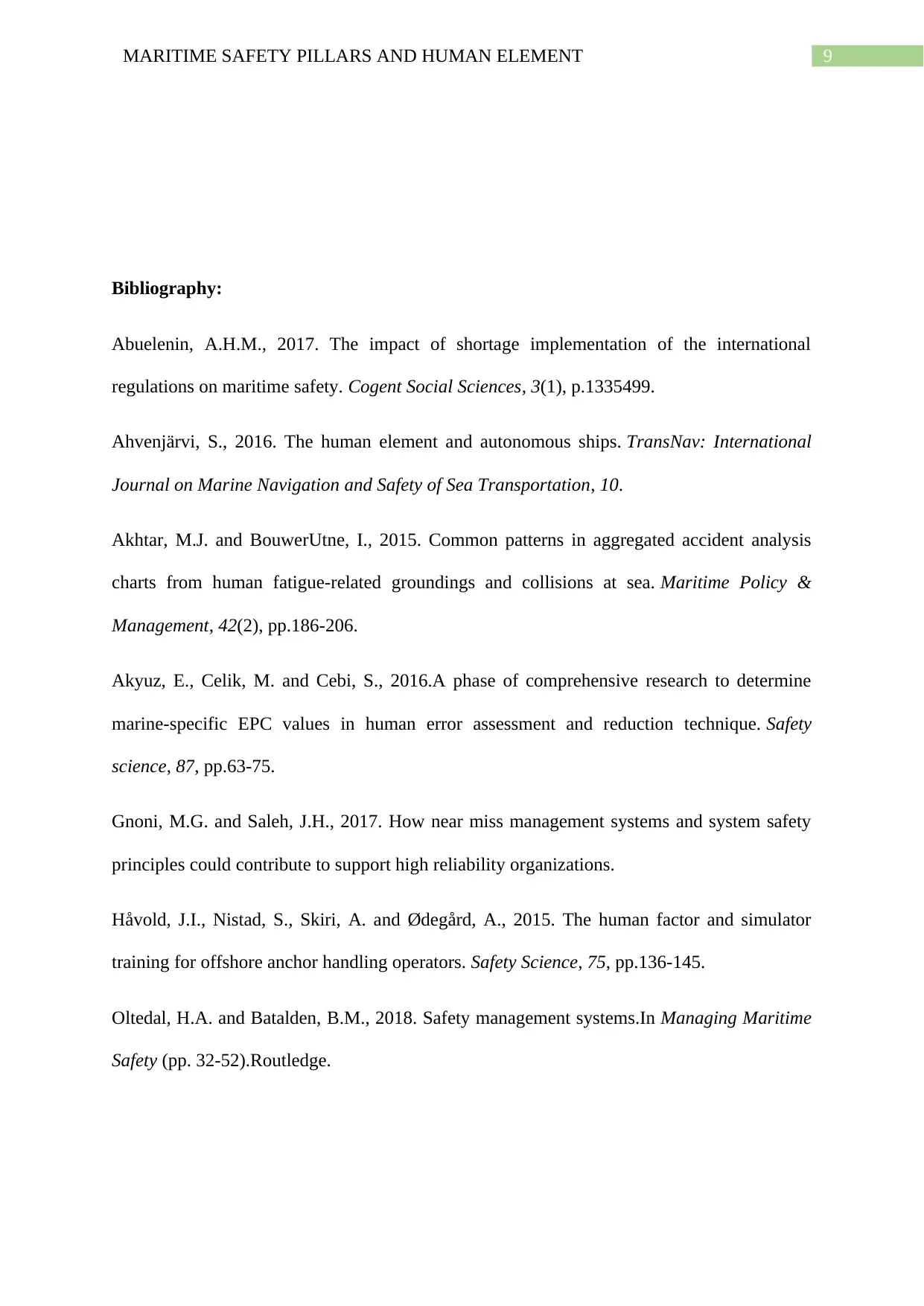
9MARITIME SAFETY PILLARS AND HUMAN ELEMENT
Bibliography:
Abuelenin, A.H.M., 2017. The impact of shortage implementation of the international
regulations on maritime safety. Cogent Social Sciences, 3(1), p.1335499.
Ahvenjärvi, S., 2016. The human element and autonomous ships. TransNav: International
Journal on Marine Navigation and Safety of Sea Transportation, 10.
Akhtar, M.J. and BouwerUtne, I., 2015. Common patterns in aggregated accident analysis
charts from human fatigue-related groundings and collisions at sea. Maritime Policy &
Management, 42(2), pp.186-206.
Akyuz, E., Celik, M. and Cebi, S., 2016.A phase of comprehensive research to determine
marine-specific EPC values in human error assessment and reduction technique. Safety
science, 87, pp.63-75.
Gnoni, M.G. and Saleh, J.H., 2017. How near miss management systems and system safety
principles could contribute to support high reliability organizations.
Håvold, J.I., Nistad, S., Skiri, A. and Ødegård, A., 2015. The human factor and simulator
training for offshore anchor handling operators. Safety Science, 75, pp.136-145.
Oltedal, H.A. and Batalden, B.M., 2018. Safety management systems.In Managing Maritime
Safety (pp. 32-52).Routledge.
Bibliography:
Abuelenin, A.H.M., 2017. The impact of shortage implementation of the international
regulations on maritime safety. Cogent Social Sciences, 3(1), p.1335499.
Ahvenjärvi, S., 2016. The human element and autonomous ships. TransNav: International
Journal on Marine Navigation and Safety of Sea Transportation, 10.
Akhtar, M.J. and BouwerUtne, I., 2015. Common patterns in aggregated accident analysis
charts from human fatigue-related groundings and collisions at sea. Maritime Policy &
Management, 42(2), pp.186-206.
Akyuz, E., Celik, M. and Cebi, S., 2016.A phase of comprehensive research to determine
marine-specific EPC values in human error assessment and reduction technique. Safety
science, 87, pp.63-75.
Gnoni, M.G. and Saleh, J.H., 2017. How near miss management systems and system safety
principles could contribute to support high reliability organizations.
Håvold, J.I., Nistad, S., Skiri, A. and Ødegård, A., 2015. The human factor and simulator
training for offshore anchor handling operators. Safety Science, 75, pp.136-145.
Oltedal, H.A. and Batalden, B.M., 2018. Safety management systems.In Managing Maritime
Safety (pp. 32-52).Routledge.
Paraphrase This Document
Need a fresh take? Get an instant paraphrase of this document with our AI Paraphraser
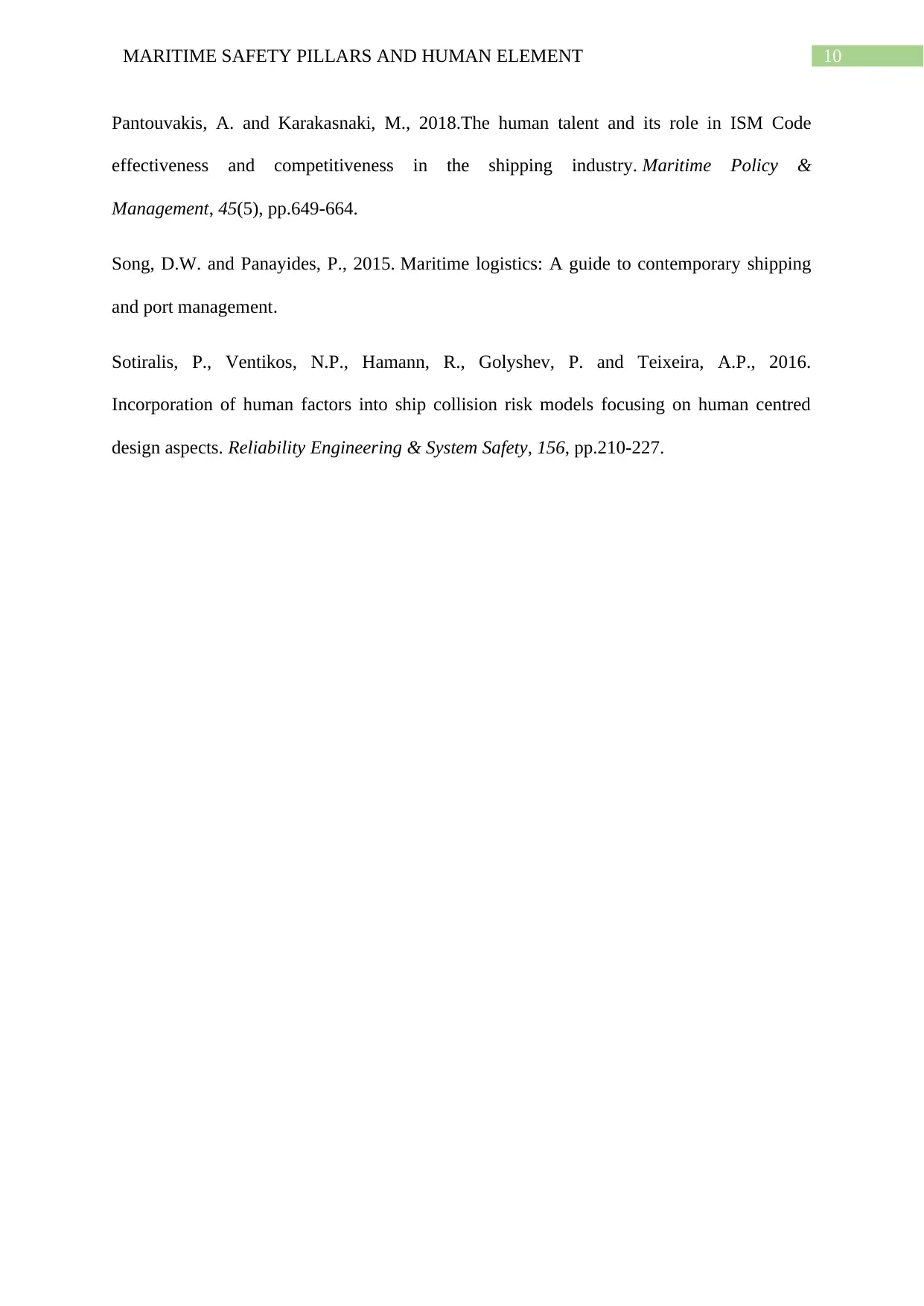
10MARITIME SAFETY PILLARS AND HUMAN ELEMENT
Pantouvakis, A. and Karakasnaki, M., 2018.The human talent and its role in ISM Code
effectiveness and competitiveness in the shipping industry. Maritime Policy &
Management, 45(5), pp.649-664.
Song, D.W. and Panayides, P., 2015. Maritime logistics: A guide to contemporary shipping
and port management.
Sotiralis, P., Ventikos, N.P., Hamann, R., Golyshev, P. and Teixeira, A.P., 2016.
Incorporation of human factors into ship collision risk models focusing on human centred
design aspects. Reliability Engineering & System Safety, 156, pp.210-227.
Pantouvakis, A. and Karakasnaki, M., 2018.The human talent and its role in ISM Code
effectiveness and competitiveness in the shipping industry. Maritime Policy &
Management, 45(5), pp.649-664.
Song, D.W. and Panayides, P., 2015. Maritime logistics: A guide to contemporary shipping
and port management.
Sotiralis, P., Ventikos, N.P., Hamann, R., Golyshev, P. and Teixeira, A.P., 2016.
Incorporation of human factors into ship collision risk models focusing on human centred
design aspects. Reliability Engineering & System Safety, 156, pp.210-227.
1 out of 11
Your All-in-One AI-Powered Toolkit for Academic Success.
+13062052269
info@desklib.com
Available 24*7 on WhatsApp / Email
![[object Object]](/_next/static/media/star-bottom.7253800d.svg)
Unlock your academic potential
Copyright © 2020–2025 A2Z Services. All Rights Reserved. Developed and managed by ZUCOL.